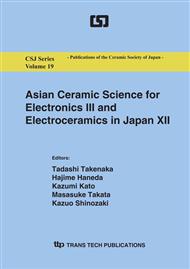p.213
p.219
p.223
p.227
p.231
p.235
p.239
p.243
p.247
Acceptor-Doped Ferroelectric Modeling via Monte Carlo Simulation
Abstract:
A 2D Monte Carlo simulation was done as an approach to get further insight of acceptor-doped ferroelectric material. By utilizing vector model allowing 14 directions of orientation for ferroelectric systems, Metropolis algorithm was applied on DIFFOUR Hamiltonian to obtain hysteresis profiles. Subjected to different concentration of acceptor dopants, power law scaling of hysteresis properties were obtained as functions of external parameters such as temperature, external field amplitude and frequency. The hysteresis loop shape and properties agreed well with those obtained experimentally.
Info:
Periodical:
Pages:
231-234
Citation:
Online since:
December 2009
Keywords:
Price:
Сopyright:
© 2010 Trans Tech Publications Ltd. All Rights Reserved
Share:
Citation:


